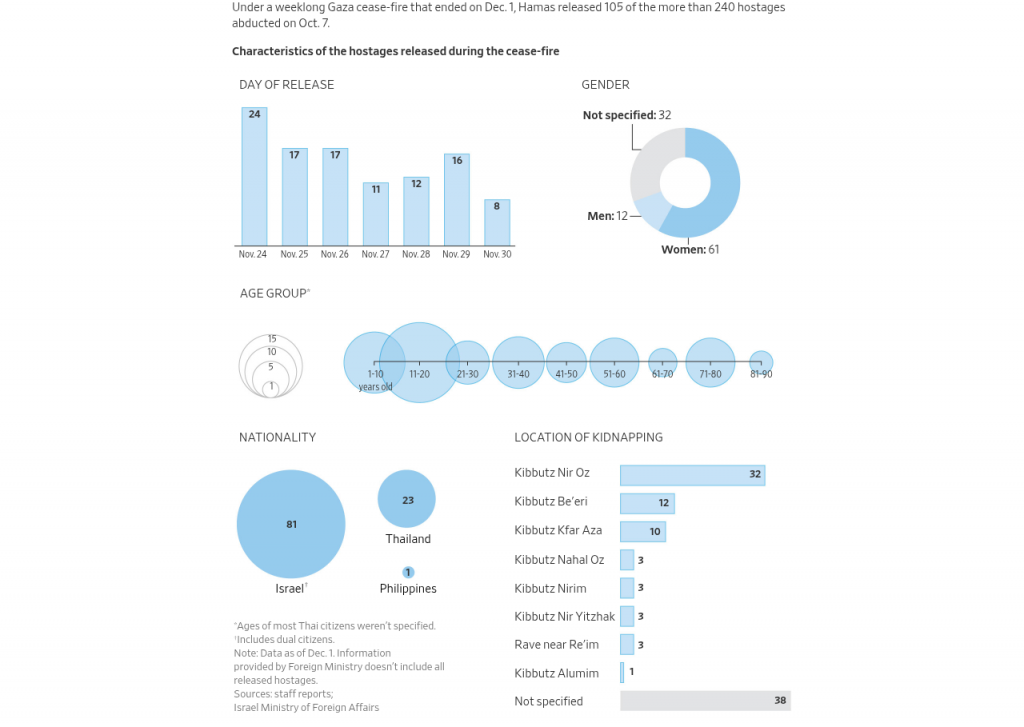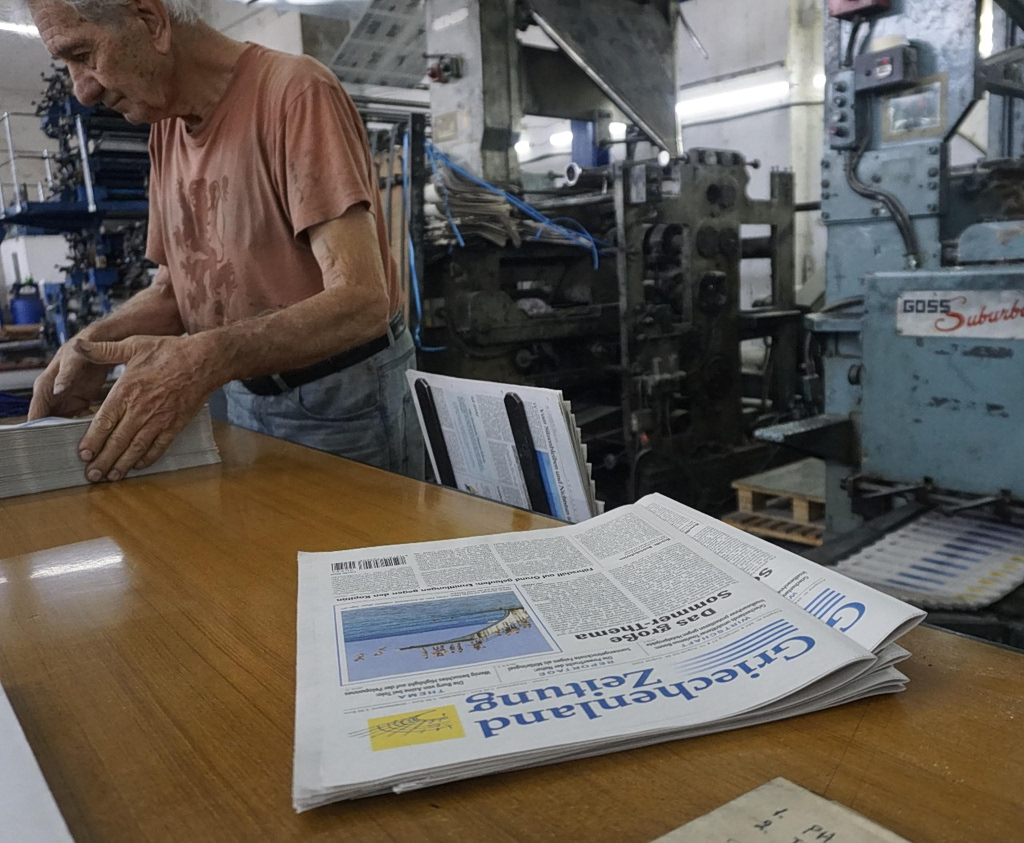The Palestinian militants who raided Israel in the Hamas attacks on Oct. 7, 2023, killed over 1,200 people, mostly civilians, according to Israel, and abducted more than 240 civilians and soldiers, bringing them back to the Gaza Strip. Israel responded with a military campaign that it said was aimed at destroying Hamas and recovering the hostages . Hamas released over 100 of the hostages during a temporary cease-fire that ended on Dec. 1, 2023. International efforts to broker a cease-fire and hostage-release deal between Israel and Hamas have repeatedly stalled.
How many hostages does Hamas have?
More than 240 hostages were taken by Hamas and other attackers on Oct. 7, 2023. Israel says there are now 94 hostages abducted that day remaining in Gaza, most of them Israeli, including dual nationals. That total includes hostages whom Israel has concluded are no longer alive.
A total of 74 hostages died either on Oct. 7, 2023, or in the months since, according to Israel, including 40 whose bodies have been brought back from Gaza. Israel says officially that 34 of the hostages abducted on Oct. 7, 2023, who remain in Gaza are dead, but Israeli officials estimate privately that the number could be much higher .
Separately, Israel said Hamas is holding the bodies of two Israeli soldiers killed in the 2014 Gaza war. Two other Israelis were captured by Hamas before Oct. 7, 2023, bringing the total number of known hostages in Gaza, dead or alive, to 98, according to Israel’s count.
Hamas, a group that the U.S. designates as a terrorist organization, said in April that it didn’t know if it could deliver 40 living civilian captives to satisfy the cease-fire proposal at the time, according to officials familiar with the negotiations.
The number of hostages who are alive and dead has been central to cease-fire proposals, which feature the exchange of hostages for Palestinian prisoners held by Israel. “The state wants to know if it is working to bring back bodies or [living] hostages,” said Ofer Merin , who is director general at Shaare Zedek Medical Center in Jerusalem and a member of the committee that determines hostage deaths.
Israel has adjusted its estimate of the number of remaining hostages as some were freed, investigators identified victims of the attacks and the Israeli military recovered bodies from Gaza.
How many hostages has the Israeli government rescued from Gaza?
The Israeli military rescued a hostage inside a tunnel in southern Gaza on Aug. 27, in the military’s first successful operation to recover a live hostage underground. Qaid Farhan Alkadi , a 52-year-old father of 11, was the eighth hostage to be freed by military operations since the start of the war. Alkadi had been kidnapped from his workplace in Kibbutz Magen, according to Israeli advocacy group the Hostages Families Forum. He is from the Bedouin Israeli city of Rahat, the military said.
On June 8, the Israeli military rescued four hostages in what it described as a complex daytime operation . The three men and one woman had been kidnapped from a music festival on Oct. 7, 2023, and were being held in two separate locations in the Nuseirat section of central Gaza, the military said.
One of the four was university student Noa Argamani , a 26-year-old woman whose abduction to Gaza on the back of a motorbike was seen in a widely shared video, and who appeared in a video released by Hamas on Jan. 15, 2024.
In February, the military rescued two hostages in a raid by a police SWAT team on a house in the southern Gaza city of Rafah. The two men had been abducted from Kibbutz Nir Yitzhak, near the Gaza border. Late in October 2023, a female soldier, Ori Megidish, was rescued by the Israeli military shortly after the beginning of Israeli ground operations in Gaza.
When will the hostages be released?
Talks on the release of hostages and a cease-fire have repeatedly stalled. Families of captives have banded together to keep hostage recovery at the top of Israel’s agenda.
Hamas had released 109 hostages as of the end of November 2023, when a cease-fire agreement that included hostage-prisoner exchanges expired. Of those, 105 were returned during the pause in fighting that began on Nov. 24, 2023, including 81 Israeli or Israeli dual nationals, 23 citizens of Thailand and one from the Philippines.
The exchanges involved only women and minors. Hamas regards Israeli men of fighting age as soldiers and a more valuable commodity.
What does Hamas want in exchange for hostages?
Hamas’s demands have included the guarantee of a permanent Israeli cease-fire and withdrawal from Gaza and the release of Palestinian prisoners held in Israeli jails. Israel has rejected the idea of a permanent cease-fire that allows Hamas to maintain any military capabilities or political authority.
Prisoner exchanges have figured prominently in the long-running Israel-Palestinian conflict. In 2011, militants in Gaza released the Israeli soldier Gilad Shalit after more than five years in captivity, in a swap for 1,027 Palestinians—including a senior Hamas leader, Yahya Sinwar, who is a primary target of Israel’s military campaign in Gaza.
What was last year’s Israel-Hamas hostage deal?
Israel and Hamas began a temporary cease-fire agreement on Nov. 24, 2023, under which civilian hostages abducted by Hamas were released in exchange for Palestinian prisoners in Israel. The agreement ended when Israel said Hamas was unable to produce a new list of hostages, prompting Israel to resume its military campaign. Talks to resume the exchanges have since stalled.
Hamas released additional hostages during the cease-fire under separate agreements with other countries.
Under the cease-fire pact, Israel also agreed to allow the delivery of fuel to Gaza from Egypt and to pause drone surveillance in northern Gaza for six hours a day.

During the first phase of the cease-fire, Hamas released 50 civilian hostages in exchange for 150 Palestinian prisoners over a period of four days, in addition to hostages released under separate agreements. Israel and Hamas extended the agreement for a total of three days, continuing a pattern of three Palestinian prisoners to be exchanged for each Israeli hostage. The releases under the deal involved only women and minors on both sides, though Hamas released men from Thailand and a Russian hostage under separate agreements.
Israeli Prime Minister Benjamin Netanyahu said the recovery of hostages remains one of Israel’s war goals along with the elimination of Hamas.
Who are the hostages?
The people taken captive in Gaza come from 29 nations including Israel, with women, children and the elderly among them. Many of the hostages hold dual nationalities. They include dozens of workers from Asia or Africa, many of them Thai farmers .
Some of the hostages were attending a music festival in southern Israel near the Gaza Strip; some were residents or visitors at kibbutzim, the farming communities in the area, where many people were slaughtered in terrorist attacks.
The captives remaining in Gaza include 13 women and two of the 39 children abducted on Oct. 7, according to Israel. Some of the remaining women are members of the Israeli military. Foreign citizens still held captive include eight from Thailand, two of whom were determined in mid-May to have died.
The White House said in mid-December 2023 that eight Americans, including three male soldiers, remained hostage . Five have since been declared dead. The bodies of four Americans are being held by Hamas, including husband and wife Gad Haggai , 73 years old, and Judi Weinstein , 70, Itay Chen , a 19-year-old Israeli sergeant, and Omer Neutra, 21. Haggai and Weinstein were killed on the day of the attack , according to a spokesman from their kibbutz . Chen was also killed by Hamas on Oct. 7, President Biden said in a statement marking his death . American-Israeli hostage Hersh Goldberg-Polin was found dead in Gaza in September along with five other hostages, whom Israel’s military said were killed by Hamas militants.
Does Hamas hold all the hostages?
Hamas transferred some of its own hostages to other factions in Gaza, according to Israel, complicating efforts to secure their freedom. Palestinian Islamic Jihad, a Hamas ally that the U.S. has designated a terrorist organization, said in October 2023 that it was holding more than 30 people abducted on Oct. 7, and in late May the group released a video of one of its captives , an Israeli-Russian dual citizen.
Israeli officials said on Dec. 3, 2023, that at least three civilian women and two children were being held by militants outside Hamas, citing their latest intelligence. That group included Israeli-Argentinian citizen Shiri Bibas and her two sons, Ariel, 4, and Kfir, 10 months, who were kidnapped by Hamas and later handed over to another faction.
Hamas has said that Bibas and her sons were dead, but Israel hasn’t confirmed that. A hostage reported by Palestinian Islamic Jihad to have died in captivity, Hanna Katzir , was released under the Israel-Hamas cease-fire deal.
Where are the hostages in Gaza being held?
Early in the war, Hamas said the hostages were kept in locations across Gaza to impede Israeli military operations in the crowded Palestinian enclave. The remaining hostages are believed to be held in sections of Hamas’s extensive tunnel network that the Israeli military has yet to clear. In a tunnel raid in the city of Khan Younis, in southern Gaza, the Israeli military said it found evidence that about 20 hostages had been there. The four hostages rescued on June 8 were held in central Gaza, in Nuseirat, while the two rescued in February were being held in Rafah in southern Gaza, the military said.
Tamar Metzger, 78 years old, who was released after 53 days, was held in tunnels in Khan Younis. She described to The Wall Street Journal enduring her time in captivity in an underground room with a group of other hostages, under the watch of four captors. Yocheved Lifshitz , one of four hostages released in October 2023, also described being held underground in what she described as a spiderweb of deep, wet underground tunnels.
How has Hamas treated the hostages?
Andrei Kozlov, a hostage rescued by Israeli forces in June, spent two months with his wrists and ankles bound by rope or chains, while his Hamas captors beat him and threatened to kill him, he told The Wall Street Journal. His guards would pile blankets on him in the hot weather or order him and his two fellow captives to stay on a dingy mattress for days at a time if he spoke out of turn or stood too close to the window, he said.
The hostages released by Hamas last year already endured grueling conditions that health experts said would have lasting psychological, if not physical, effects— especially for the children .
Their captors supplied inadequate food and water and refused to provide medication, according to accounts from family, friends and doctors who treated some of those who were released.
A hostage released in November 2023 described older captives spending days lying on mattresses and said their captors took away glasses and hearing aids when they were abducted. Hostages were held in small groups, moved around Gaza and separated from loved ones.
The released hostages struggled to adjust to light and suffered from a lack of vitamin C and physical exercise after being held in cramped conditions underground for weeks, according to a doctor. Some were treated for injuries sustained during their abduction or captivity. Most were in stable or good condition, doctors said, though an 84-year-old woman was released in critical condition .
Most of the child hostages released in November 2023 had lost between 10% and 15% of their body weight, doctors said. Many had rashes from being held in unsanitary conditions and wounds that had become infected.
Many of the children spoke in whispers after their release and ate little, saying they had to save food for later, a doctor said, a reflection of the conditions under which they were held. Some had trouble sleeping, a sign of drug withdrawal after their captors drugged them to keep them quiet and induce sleep, a psychiatrist said.



